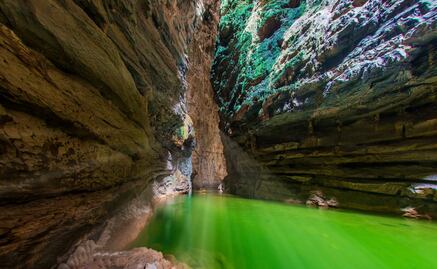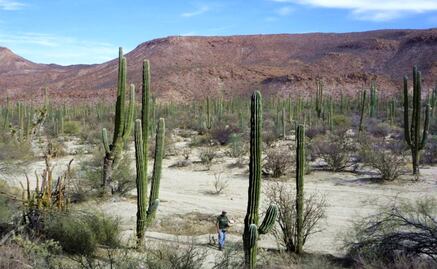El Cielo Biosphere Reserve
is the most important natural area in northeast Mexico . It was declared a Natural Protected Area in 1985 and as a World Heritage Site by UNESCO a year later. In this reserve, you will find a wide variety of flora and fauna, rivers, crystal-clear pools, and caves.
Where is it?
It is part of the Sierra Madre Oriental and it comprises the municipalities of Gómez Farias, Llera, Jaumave, and Ocampo in the state of Tamaulipas .
Why is it called El Cielo?
“The conjunction of south and north winds and the humidity of the Gulf of Mexico cause, most of the year, the clouds to be very low , giving the impression that you are located, precisely, in the sky. There are days in which one can barely walk because the clouds don’t let you see,” explains Claudia Morales de Berrones , member of the tourist agency Cielo Arriba .
El Cielo in numbers
144,530
hectares
2,200
meters above sea level
Ecosystems
Four kinds of ecosystems live in the reserve: tropical jungle, semi-desert, humid temperate rainforest, and temperate coniferous forest.
It is located in Gómez Farías, the main route to access the reserve. It is open to the public since 2010 . It is a museum that looks to give information to visitors about the relevance of the El Cielo Biosphere Reserve, of the species and attractions that can be found. It was built in a sustainable way : far from the floor so as not to affect fauna; in addition, its corridors are made of recycled plastic.
Species
According to the National Institute of Ecology and Climate Change , there is a register of over 255 species of resident birds and over 175 migratory birds . It also has endemic flora , such as the Tamaulipas magnolia, and it is home to jaguars, reptiles, and coyotes.
Monarch butterfly
From November to March, the monarch butterfly migrates from Canada to Michoacán . On its way, it stops to rest and feed in El Cielo.
The Elephant Rock
It has been forming for millions of years. The pass of time, erosion, wind, and tectonic movements created this famous rock near San José ranch , in Goméz Farías.
Valley of the UFO
Its official name is Rancho Viejo . According to locals, they have observed UFOs nearby. In addition, it is a good place to watch meteor showers . It is surrounded by a forest of pines and oaks. You can sleep in cabins or in the camping area.
Water Cave
It is a cave near San José where you can see stalagmites, and stalactites, which need 50 years to grow one centimeter. The depth of the cave is 70 meters and it is home to aquatic species with no eyes or pigmentation.
Tour
The Cielo Arriba agency offer guided tours to the reserve and transportation to San José.
Other activities
There are several options: rappelling, zip line, and horse rides, mountain bikes, and boats.
Be careful
Do not take any plant and book your reservation in advance. The boarding area is not big so as not to generate sound that can affect the animals. Visit the place with the company of a guide because it is easy to get lost.
mp
Noticias según tus intereses
[Publicidad]
[Publicidad]


















